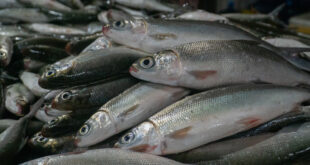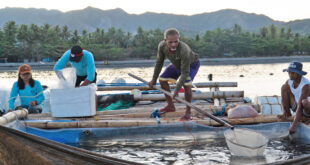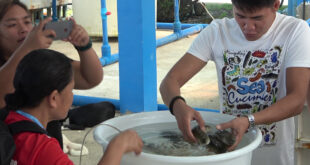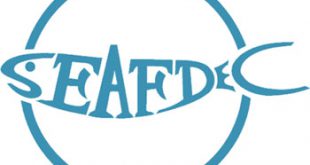 Technology Description
Technology Description
Brief description: Seabass can easily be spawned using a hormone and its larvae reared in the hatchery with 90% survival. The only potential problem for the hatchery operator is that seabass are protandrous hermaphrodites, that is, they first mature as males then become females on their sixth year or when they are over 3 kg in size. Should egg production decrease as a result of having more female broodstock, the operator must cull and acquire younger or male broodstock.
Wild spawners may be used, or breeders raised in cages,tanks or ponds. Seabass are injected with LHRHa, and left to spawn for 2-3 consecutive days. The larvae that hatched from the eggs are fed mostly live food, Brachionus and Artemia. Because the latter is quite expensive, SEAFDEC/AQD researchers had found alternatives in cladocerans (or fleas); the freshwater species is Moina and the estuarine species is Diaphanosoma and both can be collected and raised cheaply like Brachionus.
The thing to watch out for in seabass hatchery, in addition to the routine activities, is regular sorting and size-grading of fry to prevent cannibalism. A three-layered sorter box can be easily and cheaply made.
| Technology profile: | |
|
(1) Procure seabass breeders (2-8 kg) at a sex ratio of 1:2 female:male. Get egg samples by cannulation and make sure average egg diameter is at least 0.4 mm; males should give out milt. Inject with a fresh solution of LHRHa at 20-100 micrograms per kg of fish. Put them back to spawning tank or cage. Seabass will spawn on the second night after injection.
(2) Collect and incubate eggs in tanks at 1,200 eggs per liter. These hatch in about 14 hours. (3) Stock 30 seabass larvae per liter but reduce this density to 15 per li on day 10, then to 6 per li on day 21. (4) Add and maintain 1-3 x 105 Chlorella cells per ml to maintain water quality and to serve as food to rotifers; this is the same principle as in milkfish hatchery operations. It is best to introduce live food before the seabass larvae begin feeding 50 hours after hatching. (5) Feed daily ~ 15-20 Brachionus per ml on the first 12 days, 0.5 to 2 Brachionus and Artemia per ml on days 12 to 15, and finally, 5-10 Artemia per ml afterwards until harvest. The cladocerans Moina and Diaphanosoma can be fed to day 15 larvae as partial replacement to Artemia. Being live feed, there is no danger in feeding these to satiation. (6) Sort and size-grade every week such that there is not more than 30% size difference in one tank. Rear the shooters separately; they usually show after Artemia feeding. (7) Make sure the rearing tanks are cleaned daily and the water changed. (8) Harvest after 26 days of rearing. |
|
References:
Borlongan IG, Parazo MM. 1991. Effect of dietary lipid sources on growth, survival and fatty acid composition of sea bass (Lates calcarifer Bloch) fry. Israeli Journal of Aquaculture – Bamidgeh 43:95-102
Catacutan MR, Coloso RM. 1997. Growth of juvenile Asian sea bass, Lates calcarifer, fed varying carbohydrate and lipid levels. Aquaculture 149:137-144
Catacutan MR, Coloso RM. 1995. Effect of dietary protein to energy ratios on growth, survival, and body composition of juvenile Asian seabass, Lates calcarifer. Aquaculture 131:125-133
Coloso RM, Murillo-Gurrea DP, Borlongan IG, Catacutan MR. 1999. Sulphur amino acid requirement of juvenile Asian sea bass Lates calcarifer. Journal of Applied Ichthyology 15:54-58
de la Peña MR. 2001. Use of juvenile instar Diaphanosoma celebensis (Stingelin) in hatchery rearing of Asian sea bass Lates calcarifer (Bloch). Israeli Journal of Aquaculture – Bamidgeh 53:128-138
de la Peña MR, Fermin AC, Lojera DP. 1998. Partial replacement of Artemia sp. by the brackishwater cladoceran, Diaphanosoma celebensis (Stingelin), in the larval rearing of sea bass, Lates calcarifer (Bloch). Israeli Journal of Aquaculture – Bamidgeh 50:25-32
Dhert P, Lavens P, Duray M, Sorgeloos P. 1990. Improved larval survival at metamorphosis of Asian seabass (Lates calcarifer) using w3-HUFA-enriched live food. Aquaculture 90:63-74
Estudillo CB, Duray MN, Marasigan ET. 1998. Growth and survival of milkfish (Chanos chanos), sea bass (Lates calcarifer), and rabbitfish (Siganus guttatus) larvae reared at the same density in different sized tanks. Israeli Journal of Aquaculture – Bamidgeh 50:20-24
Eusebio PS, Coloso RM. 2000. Nutritional evaluation of various plant protein sources in diets for Asian sea bass Lates calcarifer Bloch. Journal of Applied Ichthyology 16:56-60
Feed Development Section. Feeds and feeding of milkfish, Nile tilapia, Asian sea bass, and tiger shrimp. Aquaculture Extension Manual No. 21, SEAFDEC Aquaculture Department, Tigbauan, Iloilo. 97 p.
Fermin AC. 1991. Freshwater cladoceran Moina macrocopa (Strauss) as an alternative live food for rearing sea bass Lates calcarifer (Bloch) fry. Journal of Applied Ichthyology 7:8-14
Fermin AC, Bolivar EC, Gaitan A. 1996. Nursery rearing of the Asian sea bass Lates calcarifer, fry in illuminated floating net cages with different feeding regimes and stocking densities. Aquatic Living Resources 9:43-49
Fermin AC, Seronay GA. 1997. Effects of different illumination levels on zooplankton abundance, feeding periodicity, growth and survival of the Asian sea bass, Lates calcarifer (Bloch), fry in illuminated floating nursery cages. Aquaculture 157:227-237
Fermin AC, Bolivar MEC. 1994. Feeding live or frozen Moina macrocopa (Strauss) to Asian sea bass, Lates calcarifer (Bloch), larvae. Israeli Journal of Aquaculture – Bamidgeh 46:132-139
Garcia LMaB. 1989. Dose-dependent spawning response of mature female sea bass, Lates calcarifer (Bloch), to pelleted luteinizing hormone-releasing hormone analogue (LHRHa). Aquaculture 77:85-96
Garcia LMaB. 1989. Development of an ovarian biopsy technique in the sea bass Lates calcarifer (Bloch). Aquaculture 77:97-102
Garcia LMaB. 1989. Spawning response of mature female sea bass, Lates calcarifer (Bloch), to a single injection of luteinizing hormone-releasing hormone analogue: effect of dose and initial oocyte size. Journal of Applied Ichthyology 5:177-184
Garcia LMaB. 1992. Lunar synchronization of spawning in seabass, Lates calcarifer (Bloch): effect of luteinizing hormone-releasing hormone analogue (LHRHa) treatment. Journal of Fish Biology 43:359-370
Garcia LMaB. 1990. Advancement of sexual maturation and spawning of sea bass, Lates calcarifer (Bloch), using pelleted luteinizing hormone-releasing hormone analogue and 17a–methyltestosterone. Aquaculture 86:333-345.
Garcia LMaB. 1990. Spawning response latency and egg production capacity of LHRHa-injected mature female sea bass, Lates calcarifer Bloch. Journal of Applied Ichthyology 6:167-172
Harvey B, Nacario JF, Crim LW, Juario JV, Marte CL. 1985. Induced spawning of sea bass, Lates calcarifer, and rabbitfish, Siganus guttatus, after implantation of pelleted LHRH analogue. Aquaculture 47:53-59.
Kohno H, Hara S, Taki Y. 1986. Early larval development of the seabass Lates calcarifer with emphasis on the transition of energy sources. Bulletin of the Japanese Society of Scientific Fisheries 52:1719-1725
Murillo-Gurrea DP, Coloso RM, Borlongan IG, Serrano Jr. AE. 2001. Lysine and arginine requirements of juvenile Asian sea bass (Lates calcarifer). Journal of Applied Ichthyology 17:49-53
Nocillado JN, Peñaflorida VD, Borlongan IG. 2000. Measures of egg quality in induced spawns of the Asian sea bass, Lates calcarifer Bloch. Fish Physiology and Biochemistry 22:1-9
Parazo MM, Avila EM, Reyes DM Jr.. 1991. Size-dependent and weight-dependent cannibalism in hatchery-bred sea bass (Lates calcarifer Bloch). Journal of Applied Ichthyology 7:1-7
Parazo MM, Reyes DM Jr., Avila EM. 1991. Hatchery rearing of sea bass Lates calcarifer Bloch. Philippine Scientist 28:65-76
Parazo MM, Garcia LMB, Ayson FG, Fermin AC, Almendras JME, Reyes DM Jr, Avila EM, Toledo JD. 1998. Seabass hatchery operations (2nd ed.). Aquaculture Extension Manual No. 18, SEAFDEC Aquaculture Department, Tigbauan, Iloilo. 42 p
Toledo JD, Marte CL, Castillo AR. 1991. Spontaneous maturation and spawning of seabass Lates calcarifer in floating net cages. Journal of Applied Ichthyology 7:217-222
 SEAFDEC/AQD Southeast Asian Fisheries Development Center | Aquaculture Department
SEAFDEC/AQD Southeast Asian Fisheries Development Center | Aquaculture Department



